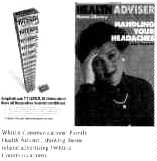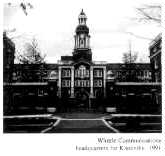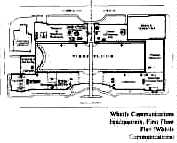
Next: Degenerate Art: An architecture of respect and retreat
Up: Hacked Inhabitants Docs • Web services are for adults only (18+).
Whittle Headquarters: An Architecture of Decency and Deceit
 The
New Corporate Style -- as distinguished from the curtain-walled office towers of
the 1950s and 1960s -- is exemplified by the corporate headquarters of Whittle
Communications in Knoxville, Tennessee. This company, now defunct, was partially
owned by Time Warner Inc., and promoted itself as being on the cutting edge of
educational reform. The celebration of pastiche in its headquarters, however,
reveals a conservatism, indeed, revisionism in its agenda.
The
New Corporate Style -- as distinguished from the curtain-walled office towers of
the 1950s and 1960s -- is exemplified by the corporate headquarters of Whittle
Communications in Knoxville, Tennessee. This company, now defunct, was partially
owned by Time Warner Inc., and promoted itself as being on the cutting edge of
educational reform. The celebration of pastiche in its headquarters, however,
reveals a conservatism, indeed, revisionism in its agenda.
Whittle had been active in three interrelated areas: the publication of
magazines directed at a specific clientele, the development of
educational/commercial television (including Channel One and the Whittle
Educational Network), and the development of a for-profit school system (The
Edison Project). Whittle publications developed a theme, were distributed free
of charge, and contained intensive advertising for products related to the
theme. The Family Health Adviser pamphlets, for example, were available, without
cost, in the waiting rooms of physicians' offices in a special display rack
provided by Whittle. The pamphlet itself contained about 40% advertisements
related to the subject. Channel One was conceptually similar. Television sets
and satellite receiving equipment were provided free of charge to the 9,000
schools (representing about 6 million students) that enrolled in the plan.
Schools were required, by contract, to tune in daily to the 12-minute
Whittle-produced news broadcast, which contained 2 minutes of advertising.
Channel One has been vigorously opposed by many school systems as an invasion of
a traditionally public, non-commercial domain by private interests with their
own commercial and political agenda. This concern, among others, was raised in
Kalamazoo, Michigan recently when four teachers were reprimanded by their
administrators for refusing to air the news program during their classes. The
Edison Project is a further attempt to market mass education as a commodity by
transferring the design of education to the private sector. Whittle conceived
and constructed model schools would be supplied as part of a total education
package to local school boards. This concept shared similarities with the
Education 2000 initiative of Secretary of Education Lamar Alexander who was, not
surprisingly, an early investor in Whittle Communications. Both Channel One and
Edison have the potential to reduce the prerogative of the teacher in
disseminating information.
 For
Whittle corporate headquarters, designer Peter Marino of New York created a
4-story complex described as an urban campus, occupying two city blocks in
downtown Knoxville. The site, formerly occupied by a Trailways bus station and
small retail/commercial venues, was bisected by Market Street, a major
pedestrian connection between the TVA complex at its northern end and the
City-County Building at the south. The city agreed to close a length of Market
Street, now incorporated within the gated Whittle complex, as the north-south
axis of a large, private open space. The new building did not replace retail or
commercial uses at the street level, and pedestrian activity is limited to those
who use its several entrances. It is an example of the process of gentrification
of downtowns, or what is left of them, that excludes 'dirty' uses.
For
Whittle corporate headquarters, designer Peter Marino of New York created a
4-story complex described as an urban campus, occupying two city blocks in
downtown Knoxville. The site, formerly occupied by a Trailways bus station and
small retail/commercial venues, was bisected by Market Street, a major
pedestrian connection between the TVA complex at its northern end and the
City-County Building at the south. The city agreed to close a length of Market
Street, now incorporated within the gated Whittle complex, as the north-south
axis of a large, private open space. The new building did not replace retail or
commercial uses at the street level, and pedestrian activity is limited to those
who use its several entrances. It is an example of the process of gentrification
of downtowns, or what is left of them, that excludes 'dirty' uses.
 The
neo-Georgian architecture, suggesting familiarity and gentility, can best be
described as 'decent,' one of several code-words used by the Nazis to describe
what 'degenerate' art was not. Philip Morris, editor of Southern Living
magazine, has called it "a darn good way to make a building." Its brick facades
pierced by small, double-hung windows suggest traditional bearing-wall
construction, but the building, responsive to a 1990 budget, has a steel frame
with metal stud exterior walls clad in brick veneer. The use of repetitive
window openings might indicate partitioned interior spaces such as small
offices, but the space planning is efficiently modern, with expansive open-plan
work areas punctuated by enclosed rooms that contain the more private functions.
The insistent symmetry of the plan contradicts the functionally-diverse physical
program and a site that contains many possibilities for asymmetrical
development. Bruno Zevi assigns political and psychological meaning to the use
of symmetry:
The
neo-Georgian architecture, suggesting familiarity and gentility, can best be
described as 'decent,' one of several code-words used by the Nazis to describe
what 'degenerate' art was not. Philip Morris, editor of Southern Living
magazine, has called it "a darn good way to make a building." Its brick facades
pierced by small, double-hung windows suggest traditional bearing-wall
construction, but the building, responsive to a 1990 budget, has a steel frame
with metal stud exterior walls clad in brick veneer. The use of repetitive
window openings might indicate partitioned interior spaces such as small
offices, but the space planning is efficiently modern, with expansive open-plan
work areas punctuated by enclosed rooms that contain the more private functions.
The insistent symmetry of the plan contradicts the functionally-diverse physical
program and a site that contains many possibilities for asymmetrical
development. Bruno Zevi assigns political and psychological meaning to the use
of symmetry:
"Symmetry is the facade of sham power trying to appear invulnerable. [It is]
fear of flexibility, indetermination, relativity and growth -- in short, fear of
living."
"Symmetry is one of the invariables of classicism. Therefore asymmetry is an
invariable of the modern language. Once you get rid of the fetish of symmetry,
you will have taken a giant step on the road to a democratic architecture."
But democracy, or power through representation, is not what Whittle
was about. By hiding its true nature behind an historicist facade, the building
accurately reflects the philosophy of a company whose product is advertising
hidden behind a veneer of 'information.' (Whittle correctly and unapologetically
asserts that exposure to advertising is the price we usually pay to receive
information.) The project has, indeed, been considered by the architectural
press in terms of its image, rather than as a 'serious' piece of design. Its
visual language communicates a deliberate critique of modern architecture --
indeed, of 'elitist' taste -- in a way that the populist language of the
company's publications delivers a subtle critique of intellectualism. Not
wishing to give it too much prominence or risk criticism for praising it,
Progressive Architecture chose a student intern writer to summarize the
building's (and the company's) message:
"In an age of star designers, it is refreshing to see work that clearly
reflects the will of a client, rather than the ego of the architect.
Equally refreshing is an office building which refuses to succumb to the
'corporate aesthetic.' "
The author fails to suggest that the Whittle headquarters represents a new
corporate aesthetic, one that is perhaps more efficient and audacious than the
old. The building, through its aesthetic, not only projects the image of a
company that confuses concern for society and concern for profit, but subtly
attacks those 'elitists' who might challenge its authority.
Whittle Headquarters: An Architecture of Decency and Deceit ·
Degenerate Art: An architecture of respect and retreat ·
Lessons of fascism ·
Epilogue ·
Fax from Leon Krier to Professor Kaplan
Hacked Inhabitants Docs
© 1999-2021
 The
New Corporate Style -- as distinguished from the curtain-walled office towers of
the 1950s and 1960s -- is exemplified by the corporate headquarters of Whittle
Communications in Knoxville, Tennessee. This company, now defunct, was partially
owned by Time Warner Inc., and promoted itself as being on the cutting edge of
educational reform. The celebration of pastiche in its headquarters, however,
reveals a conservatism, indeed, revisionism in its agenda.
The
New Corporate Style -- as distinguished from the curtain-walled office towers of
the 1950s and 1960s -- is exemplified by the corporate headquarters of Whittle
Communications in Knoxville, Tennessee. This company, now defunct, was partially
owned by Time Warner Inc., and promoted itself as being on the cutting edge of
educational reform. The celebration of pastiche in its headquarters, however,
reveals a conservatism, indeed, revisionism in its agenda. 
 For
Whittle corporate headquarters, designer Peter Marino of New York created a
4-story complex described as an urban campus, occupying two city blocks in
downtown Knoxville. The site, formerly occupied by a Trailways bus station and
small retail/commercial venues, was bisected by Market Street, a major
pedestrian connection between the TVA complex at its northern end and the
City-County Building at the south. The city agreed to close a length of Market
Street, now incorporated within the gated Whittle complex, as the north-south
axis of a large, private open space. The new building did not replace retail or
commercial uses at the street level, and pedestrian activity is limited to those
who use its several entrances. It is an example of the process of gentrification
of downtowns, or what is left of them, that excludes 'dirty' uses.
For
Whittle corporate headquarters, designer Peter Marino of New York created a
4-story complex described as an urban campus, occupying two city blocks in
downtown Knoxville. The site, formerly occupied by a Trailways bus station and
small retail/commercial venues, was bisected by Market Street, a major
pedestrian connection between the TVA complex at its northern end and the
City-County Building at the south. The city agreed to close a length of Market
Street, now incorporated within the gated Whittle complex, as the north-south
axis of a large, private open space. The new building did not replace retail or
commercial uses at the street level, and pedestrian activity is limited to those
who use its several entrances. It is an example of the process of gentrification
of downtowns, or what is left of them, that excludes 'dirty' uses.  The
neo-Georgian architecture, suggesting familiarity and gentility, can best be
described as 'decent,' one of several code-words used by the Nazis to describe
what 'degenerate' art was not. Philip Morris, editor of Southern Living
magazine, has called it "a darn good way to make a building." Its brick facades
pierced by small, double-hung windows suggest traditional bearing-wall
construction, but the building, responsive to a 1990 budget, has a steel frame
with metal stud exterior walls clad in brick veneer. The use of repetitive
window openings might indicate partitioned interior spaces such as small
offices, but the space planning is efficiently modern, with expansive open-plan
work areas punctuated by enclosed rooms that contain the more private functions.
The insistent symmetry of the plan contradicts the functionally-diverse physical
program and a site that contains many possibilities for asymmetrical
development. Bruno Zevi assigns political and psychological meaning to the use
of symmetry:
The
neo-Georgian architecture, suggesting familiarity and gentility, can best be
described as 'decent,' one of several code-words used by the Nazis to describe
what 'degenerate' art was not. Philip Morris, editor of Southern Living
magazine, has called it "a darn good way to make a building." Its brick facades
pierced by small, double-hung windows suggest traditional bearing-wall
construction, but the building, responsive to a 1990 budget, has a steel frame
with metal stud exterior walls clad in brick veneer. The use of repetitive
window openings might indicate partitioned interior spaces such as small
offices, but the space planning is efficiently modern, with expansive open-plan
work areas punctuated by enclosed rooms that contain the more private functions.
The insistent symmetry of the plan contradicts the functionally-diverse physical
program and a site that contains many possibilities for asymmetrical
development. Bruno Zevi assigns political and psychological meaning to the use
of symmetry: